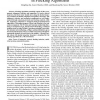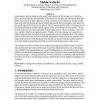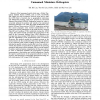985 search results - page 170 / 197 » Biomimetic robot navigation |
CA
1999
IEEE
14 years 1 months ago
1999
IEEE
This paper presents a simple and efficient method of modeling synthetic vision, memory, and learning for autonomous animated characters in real-time virtual environments. The mode...
AROBOTS
2007
13 years 9 months ago
2007
Gradient descent in image distances can lead a navigating agent to the goal location, but in environments with an anisotropic distribution of landmarks, gradient home vectors devia...
TFS
2008
13 years 9 months ago
2008
Abstract--Flocking algorithms essentially consist of three components: alignment, cohesion, and separation. To track a desired trajectory, the flock center should move along the de...
AROBOTS
2008
13 years 9 months ago
2008
Autonomous mobile robots need to adapt their behavior to the terrain over which they drive, and to predict the traversability of the terrain so that they can effectively plan thei...
ICRA
2010
IEEE
13 years 7 months ago
2010
IEEE
Abstract— Most unmanned aerial robots use a Global Navigation Satellite System (GNSS), such as GPS, GLONASS, and Galileo, for their navigation. However, from time to time the GNS...



